Vibrating Tables for Mineral Cast
Vibrating table for the produktion of prefabricated mineral cast
![[Translate to Englisch:] Rütteltisch für die Fertigung von Teilen aus Mineralguss / Polymerbeton](/assets/produkte/ruetteltische/1-Ruetteltisch-Vibrating-tabel-Mineralguss-polymer-mineral-concrete-Gitter.jpeg)
Vibrating table for the produktion of prefabricated mineral cast
![[Translate to Englisch:] Rütteltisch für die Fertigung von Teilen aus Mineralguss / Polymerbeton](/assets/produkte/ruetteltische/2-Ruetteltisch-Vibrating-tabel-Mineralguss-polymer-mineral-concrete-1-Reihe.jpeg)
Vibrating table for the produktion of prefabricated mineral cast
![[Translate to Englisch:] Rütteltisch für die Fertigung von Teilen aus Mineralguss / Polymerbeton](/assets/produkte/ruetteltische/3-Ruetteltisch-Vibrating-tabel-Mineralguss-polymer-mineral-concrete-2-Reihen.jpeg)
Vibrating table for the produktion of prefabricated mineral cast
This plant has been developed for the company EPUCRET for the production of machine frames out of mineral casting. EPUCRET has been active for over 20 years at the cutting edge of polymer-bonded mineral casting technology and offers its customers from the mechanical, plant and appliance engineering industries a competent all-round service for system solutions using mineral castings. (for further information see www.epucret.de).
During the development of the machine it had to be considered that the production program reaches from small over medium sized to large products und that these had to be produced efficiently on this plant. The plant consists of 2 vibrating table which are suspended by air springs and which can be run simultaneously or independently. The working level is being kept constant by a level control. During the production of small and medium sized products this design allows to produce 2 parts at a time with different vibration settings. When a large product has to be produced, the vibrating tables get connected electrically in a way, that the level control and the vibration run absolutely synchronous.
| Technische Daten: | Vibrating table | Total system |
| Width: | 3100 mm | 3100 mm |
| Length: | 3900 mm | 7800 mm |
| Max. payload: | 15.000 kg | 30.000 kg |
| Frequency range: | 10 - 80 Hz | 10 - 80 Hz |
| Displacement: | 0 - 0,25 mm | 0 - 0,25 mm |
| Unbalance: | 0 - 19 Nm | 0 - 38 Nm |
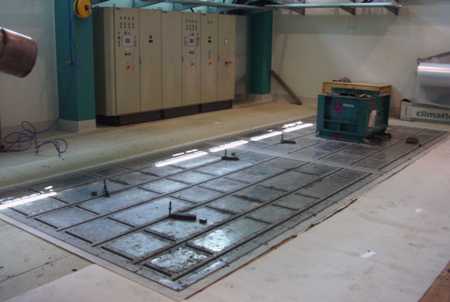
The vibration of the tables is being generated by external powered vibration elements. Each table is being powered by 4 asynchronous servo motors, which each drives 4 vibrating elements.
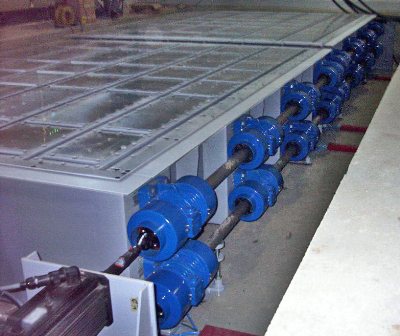
The use of asynchronous servo motors allows changing the position of the driven unbalances on the shafts towards each other. In this system each 2 shafts are a pair and the shafts are counterrotating, but synchronous. If now the position of the 2nd pair gets changed towards the position of the 1st pair in the range of 0 to 180°, the amplitude will change between 0 and 100%. Due to the fact that 4 shafts are needed for such system, it is called 4-shaft-technique.
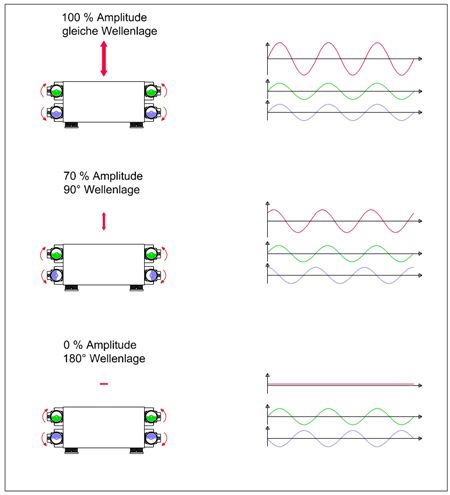
During the filling of the moulds the weight on the vibrating table increases and the level of the table decreases. This will be corrected from the level control automatically by increasing the pressure in the air springs. The level control is very important during the production of large work pieces, because the 2 tables are not mechanically connected, but the levels of both tables have to be the same at all times. To achieve this difficult requirement retroreflective sensors with a small hysteresis are being installed on all 4 corners of the tables.

The equipment can be operated from a central switch cabinet. The cabinet contains the PLC, which on one side enables the automation of the production process and on the other side controls the total system with its components and displays the detailed reason of occurring problems on the screens. On top of that the manufacturer of the equipment can support the troubleshooting with a remote maintenance system.
Each of the tables has a complete set of controls, including touch screen. With a turn of a key switch the table can be connected and the system can be operated from either set of controls. Also the actual acceleration of each table can be read from additional displays at all time.
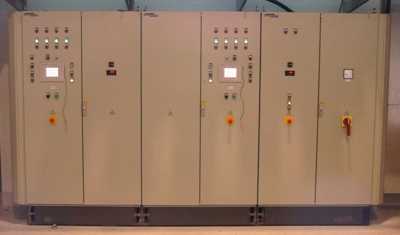
![[Translate to Englisch:] Ansprechpartner](/assets/content/dummy-ansprechpartner.png)
Contact person
For questions about the product range "Vibrating tables", please contact
Peter Ortmann
08171 - 6295-24
E-Mail
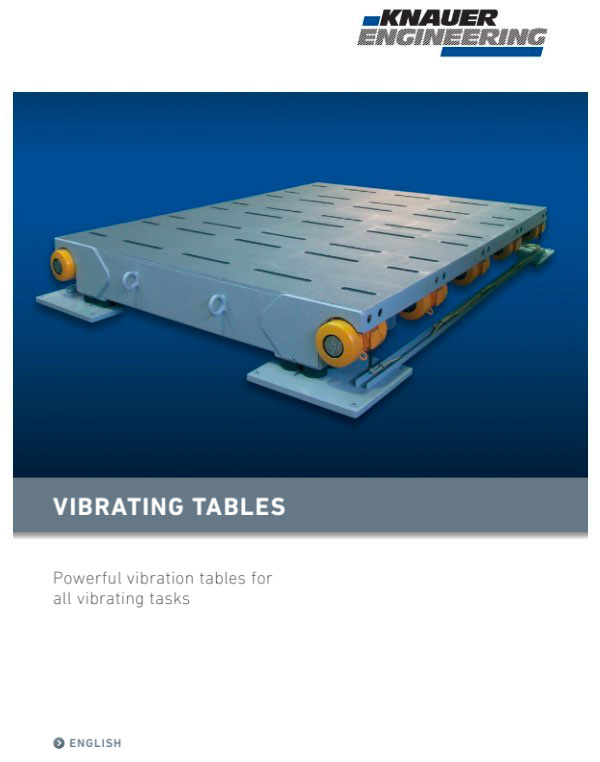
![[Translate to Englisch:] Rütteltische Standard](/assets/slider/Ruetteltische-Standard.jpg)
![[Translate to Englisch:] Rütteltische Kundenspezifisch](/assets/slider/Ruetteltische-Kundenspezifisch.jpg)
![[Translate to Englisch:] Rütteltische Gabionenbau](/assets/slider/Ruetteltische-Gabionenbau.jpg)
![[Translate to Englisch:] Rüttelböcke](/assets/slider/Ruettelboecke.jpg)
![[Translate to Englisch:] Rüttelsiebe](/assets/slider/Ruettelsiebe.jpg)
![[Translate to Englisch:] Big Bag Rüttelrahmen](/assets/slider/Big-Bag-Ruettelrahmen.jpg)